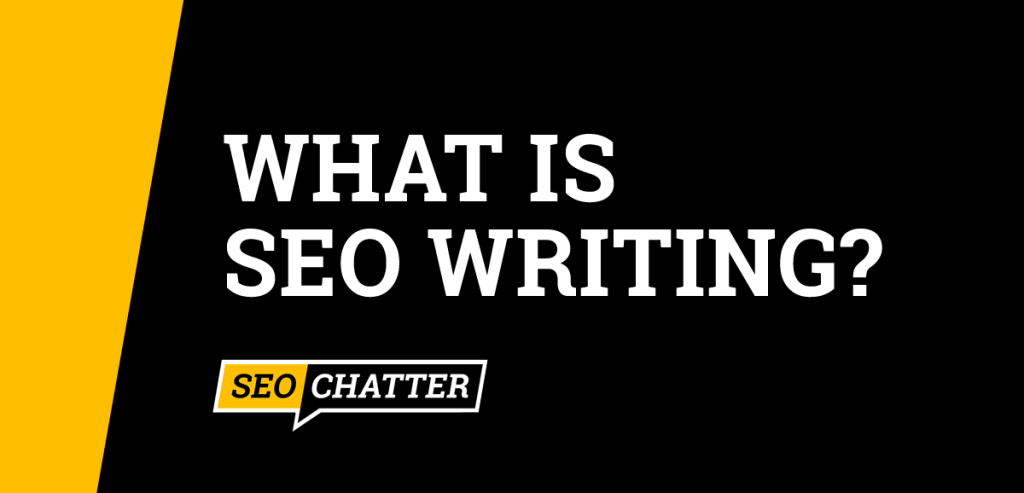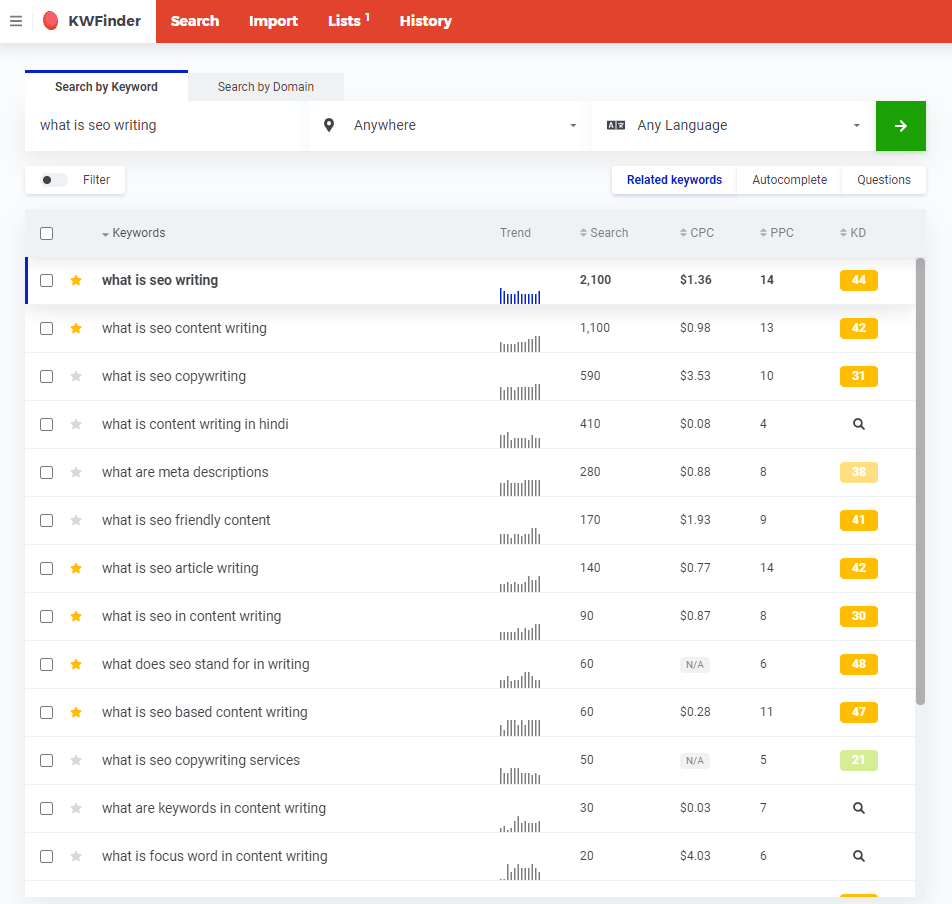In this article, we’ll answer the question, “what is SEO writing?”
In addition to the definition and meaning for SEO writing, you’ll also understand the importance of SEO based writing and find a list of SEO content writing tips to help you rank your articles higher in search engines like Google, Yahoo, and Bing.
By the end of this page, you’ll understand the important concepts of search engine optimization writing and how it can be used to improve the organic visibility of your website in the search engine results pages (SERPs).

What Is SEO Writing?
SEO writing is the process of writing content with SEO to help it rank on the first page of search engines like Google, Yahoo, and Bing. SEO writing uses keywords within the content to improve relevance for search queries that match user intent.
Why SEO Writing Is Important
SEO writing is important because it increases your website’s organic rankings on search engines like Google, Yahoo, and Bing. Search engine algorithms look for important keywords in the content to help identify the search queries it should rank for organically.
Now, keep in mind that an SEO writer is different than an SEO copywriter who uses persuasive language in the copy to sell products in advertising and marketing. SEO writers, on the other hand, are technical writers who use search engine optimization techniques to make sure the article is well-optimized for the ranking algorithms. See my article on what is an SEO copywriter to read more about the differences between these two skill sets.

SEO Content Writing Tips
1. Choose 2-3 SEO Keywords for the Content
The first step in SEO content writing is to choose your target keywords for the article. It’s best to pick at least 2-3 related keywords for every piece of SEO content you write so you can maximize visibility in the search engines.
For example, this page is targeting these three related keywords phrases:
- what is SEO writing
- what is SEO content writing
- what is SEO article writing
Although the terms are slightly different, there are several websites ranking in Google for each variation. That means it’s important for this article to target all three keyword phrases within the SEO based content.
You can find related terms like this for your articles by using a keyword research tool like KWFinder by Mangools (try it for free). It’s one of the only SEO tools I recommend as an affiliate because it’s cheap, yet powerful for keyword research.
With KWFinder, you can type in a seed keyword and get a list of other related terms people are actively searching for on Google. This takes the guesswork out of finding good organic keywords to target in your SEO writing.
The image below shows an example of how I found the related keywords for this article using KWFinder. And by clustering those key phrases together on the same page, I can improve the organic search traffic for all of them.

2. Study the Competition for Article Ideas
After you’ve selected your target keywords for the page, the next step in SEO writing is to come up with an idea for the article. There are two ways you can approach this process:
- Guessing what to write about.
- Studying the competition.
The first option is not the best choice for SEO article writing because you could end up wasting a lot of valuable time writing content that doesn’t give Google’s algorithm the type of information it wants to see on the page to rank for its target keywords.
The second option is the better choice because you can take clues from the sites that are already ranking high in the search engines. These competitors are clearly satisfying the needs of the algorithm for the SEO keyword phrases to get into those top positions.
Therefore, you should spend a few minutes analyzing the top 3-5 competitors to see what type of content they’re including in the content. Look for overlapping sections in the heading tags (H2s and H3s) and then make sure to include the same information in your SEO article.
Working this way will ensure that you’re meeting the user search intent without having to guess what people and the ranking algorithms want to find on the page for the target keywords.
3. Outline the Content
The next step for SEO article writing is to create the outline for the content. After analyzing your top competitors, you should have a clear idea of the common types of content that are being written about on those sites.
There’s almost always a pattern to be found here to help you outline your SEO content. But if for some reason you don’t see any patterns (which can happen for a long-tail keyword), then the best process to follow for writing SEO content is to take the most important section ideas from the top-ranking articles to create a best-of-the-best article.
4. Put Keywords In the Headings
Once you have the section ideas gathered, you can start writing the headings for each major section you’re going to be covering in the SEO based content. These headings should be formatted as H2 tags which carry significant weight for on-page SEO.
A top tip here is to put your main SEO keyword in the first H2 subheading on the page, which should appear directly after the introduction. Then, put the secondary keywords in their own H2s on the page wherever it fits naturally.
Next, you can use keyword variations and partial match keywords in the H3 tags that are subheadings under relevant H2s. This helps improve the topical relevance for SEO without over-optimizing the subheadings for the exact match keyword phrase.
You can see that I used this exact same SEO writing process to outline this article here. Nothing on this page was written by chance. I got all of the ideas for each of the H2 and H3 sections of the page from the top 5 ranking competitors. I then back through and adding in relevant SEO keywords to optimize the content properly for on-page SEO.
5. Write the SEO Content
After the SEO article outline is complete, the next step is to write the content for the page. You do this by filling in each section of the outline by writing comprehensive content for the user. Also, try to make the article better than the top-ranking competitors so the reader gets everything they need to know about the topic under each heading.
The more in-depth you go with your SEO writing, the better it is for ranking in the search engines. Additionally, longer content tends to outrank shorter content. So aim to write at least 200-300 words more than the average word count on the top-ranking pages on Google.
Also, writing longer content for SEO gives you more opportunities to insert your target keywords and other relevant phrases to increase the total number of search queries your article page ranks for in the SERPs.
6. Add Relevant Keywords to the Article
Once your first draft is complete, the next step in SEO content writing is to go back through the article and add other relevant keywords to improve the topical authority of the page. Examples of this include synonyms and semantically related words that are associated with the main topic.
This is a key step when doing SEO article writing that many beginner SEO writers neglect. Expertise, authority, and trust (E-A-T) are important factors for Google’s ranking algorithm. and SEO based content that lacks synonyms and semantically related words indicates to the ranking algorithms that it was not written by an expert on the subject.
A classic example to illustrate this SEO writing practice is an article written about Apple, Inc. Well-optimized content for a page on this topic would include words like mac, iPhone, iPad, technology, electronics, software, computer, etc. The inclusion of those synonyms and semantically related words helps Google’s search engine crawler understand that the page is about Apple, the company, and not an apple, the fruit. If the article didn’t have those technology-related words, then the page would have a lower semantic SEO score, which also means it would have a harder time ranking for its target keywords.
To further drive home this point, I put this SEO content writing tip into practice immediately after I wrote this guide. After I was done writing for you (the reader), I went back through and added synonyms and topically relevant words and key phrases like the ones listed below to help improve the semantic relevance:
- search engine optimization
- on-page SEO
- article writing
- content writing
- keywords
- queries
- algorithm
- Yahoo
- Bing
- optimize
- articles
- written
- writer
- research
- outline
- links
If you’re not sure what related words to include on the page, just go to Wikipedia and search for the main topic. All of the hyperlinks on the topic page are semantically related entities that you can include within the SEO content. Another strategy is to invest in an SEO writer tool like Surfer SEO, which provides a list of relevant key phrases to include within the article for better search engine optimization.
7. Optimize the Content for SEO
After your content is fully outlined and written, the next step is to optimize the body of the article for SEO.
You can get some fast results by adding your keywords to three basic areas of the content listed below in addition to the heading tags as mentioned in the previous tip.
- Within the first 100 words of the introduction.
- 2-3 times scattered in the middle of the page.
- Within the last 100 words of the summary.
8. Optimize the Title Tag
In addition to doing good SEO in the content, you also have to optimize the meta title tag for the target keywords. This is an HTML element that Google pulls to display for your article in the search engine results pages that people click on the visit your web page. Therefore, you want to optimize the title tag for both SEO and click-through rates.
For SEO article writing, you’ll need to put your main target keyword at the beginning of the meta title tag field and also try to include the secondary keywords where they sound natural, and without repeating too many of the same words. Also, keep the title tag between 60-65 words so it doesn’t get cut off in the SERPs when Google displays it.
As for increasing the click-through rates for your listing, you’ll want to add enticing language to the title tag and create curiosity where you can. The more you can encourage people to click on your listing versus the competition, the more Google will see this as a positive signal and increase your rankings for the query.
You can see this SEO content writing tip in practice on this page. The meta title includes the target SEO keyword at the beginning of the field (What Is SEO Writing) as well as the secondary keyword phrase (SEO Content Writing Tips). I also made it more click-worthy than the top-ranking competitors by providing 12 tips instead of 7 or 10, which is what they have.
Note: This step is also important for SEO analysis to improve the rankings for existing content. See my guide on what is SEO analysis for more details.
9. Write a Good Meta Description
The meta description is another HTML field that is pulled by Google to display under your listing. Some people ignore the meta description when writing SEO content because it’s not a direct ranking factor for the algorithm. However, Google highly recommends writing a good meta description in its SEO Starter Guide for the following reason:
“Description meta tags are important because Google might use them as snippets for your pages. Note that we say ‘might’ because Google may choose to use a relevant section of your page’s visible text if it does a good job of matching up with a user’s query. Adding description meta tags to each of your pages is always a good practice in case Google cannot find a good selection of text to use in the snippet.”
Therefore, you should always optimize your meta description for SEO writing and to get more clicks. To do this, include as many of your target keywords as possible without it sounding unnatural. Put your main keyword first in the field. And use language that entices the searcher to want to click on your listing.
Take clues from the top-ranking pages on Google for your target keywords to know how to optimize it well for SEO and clicks. You can get good ideas and examples directly from the SERPs so you don’t have to guess what to write or include for SEO.
10. Add Internal Links to Relevant Content
As explained in this other guide on how to write an SEO friendly article, internal links are beneficial for both your users and the search engines. Therefore, it’s important to include internal links when you’re doing SEO content writing.
Internal links are good for users because they help people find related content on your website. They’re also good for search engines because they help web crawlers find and index more content on your site. Plus, search engines like Google use the anchor text for internal links as an on-site signal for keyword relevance.
Follow these tips for better SEO content:
- Include at least 3-5 internal links to each web page.
- Use the main target keyword for the page as the anchor text for the first set of internal links.
- For internal links you build above number 5, use this strategy: Put the secondary keyword in the anchor text for links 6-8 and use a third keyword phrase or partial match variation for internal links 9-11.
11. Include External Links to Authoritative Sources
Although Google claims that linking out to quality sites is not a direct ranking factor, the company has also made statements that it can impact your search engine performance. Additionally, SEO case studies like the one from Reboot Online Marketing show that linking out to relevant, authoritative sites can result in a positive effect on rankings and visibility.
In many ways, Google’s algorithm seems to trust sites less when they link to spammy or low-quality sites on the Internet, and parts of the ranking system encourage links to authoritative or high-quality sites.
Therefore, when you’re writing SEO content, it’s best to always include a few external links to authoritative sources on the web. An easy way to do that is by citing websites that rank high in the search engines for relevant keywords to back up data and claims made in the article. You can see this SEO tip in practice in the previous paragraph where I linked out to the Reboot Online Marketing case study as well as the previous tip where I linked to Google’s SEO Starter Guide.
12. Add Optimized Images
The final tip for SEO content writing is to add optimized images to the article. Image SEO is also an important ranking factor for content on the Internet. When you add relevant images that are optimized for search engines, you can help improve the topical relevance of the page as well as gain additional traffic from Google Image Search.
To optimize images correctly for SEO articles, follow these simple tips:
- Include at least one image in the content for the top 1-3 target keyword for the page.
- Assign each image to a single SEO keyword.
- Use the target keyword in the image filename and ALT text field.
- Place the optimized images next to their relevant H2 subheadings. (As mentioned in a previous step, you should put each of your main target keywords in their own H2 tags.)
Now, if you want to improve your SEO article writing skills even further, then check out this related guide on what is SEO strategy. It includes a complete walk-through on how to develop an SEO plan for your website as well as additional content writing tips and action templates you can copy for success.
Learn More About SEO Writing
The links below explain more about SEO writing to help you better optimize your articles and blog posts. Use these resources to expand your knowledge on the subject.
- What Is SEO Content?
- SEO Content Writing Checklist
- SEO Content Writing Tips
- SEO Checklist for Blog Posts
- SEO Writing for Beginners
- How to Write SEO Friendly Content

SEO Writing Summary
I hope you enjoyed this guide answering the question about what is SEO writing.
As you discovered, the process of SEO content writing is using SEO to help articles rank on the first page of search engines like Google, Yahoo, and Bing. And to do this well, you need to combine article research, writing, and content optimization to rank web pages higher in the SERPs. By using the keyword tips and content writing strategies on this page, you can help improve the article’s relevance for search queries that match user intent.

SEO Chatter is dedicated to teaching the fundamentals of search engine marketing to help marketers understand how to increase organic website traffic and improve search engine rankings.
